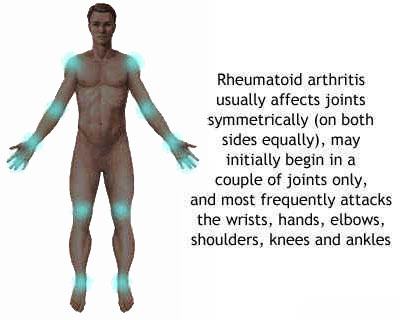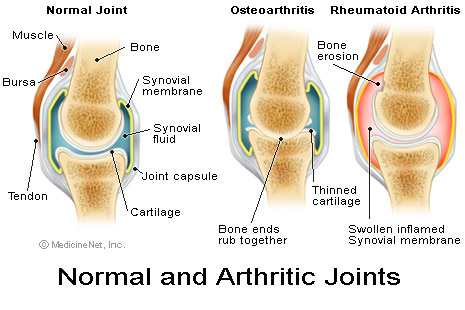Pain
Arthritis
is very common. It is a major cause of lost work
time and can cause serious disability.
There is more than one type of arthritis with
osteoarthritis being the most common form. This condition
is due to wear and tear in the joints and is more common
in people over 50. It is very painful in the
weight-bearing joints such as the knees and hips.
Cartilage wears away on the bone ends causing pain and
swelling. Osteoarthritis may develop after an injury such
as bone fracture or a joint dislocation.
Rheumatoid arthritis is due to inflammation or swelling
of the joint lining which damages the joint. It can occur
at any age and in more than one joint. This is caused by
underlying rheumatic disease and is common in the hands
and feet.
Rheumatoid Arthritis
Rheumatoid arthritis is an autoimmune disease in which
the body's immune system attacks itself. The pattern of
joints affected is usually symmetrical, involves the hands
and other joints and is worse in the morning. Rheumatoid
arthritis is also a systemic disease, involving other body
organs, whereas osteoarthritis is limited to the joints.
Over time, both forms of arthritis can be crippling.
Rheumatoid arthritis is a systemic autoimmune disease
which initially attacks the synovium, a connective tissue
membrane that lines the cavity between joints and secretes
a lubricating fluid.
The affect of rheumatoid arthritis can progress to the
degree that it is crippling. Deformities distinctive to
late-stage rheumatoid arthritis such as ulnar deviation of
the bones of the hands, or swan-neck deviation of the
fingers occur because muscles and tendons on one side of
the joint may overpower those on the other side, pulling
the bones out of alignment
 

Osteoarthritisis a chronic
disease causing deterioration of the joint cartilage (the
softer parts of bones, which cushion their connections to
each other) and the formation of new bone (bone spurs) at
the margins of the joints.

Fibro-myalgia, sometimes known as Fibro-myalgia
Syndrome (FMS) is a chronic condition associated with
muscle pain (aching) all over the body, stiffness and
tiredness. Pain occurs often in the neck, shoulders, upper
back and hips. Often patients have very interrupted sleep.
Much is still unknown about the condition, which can be
associated with psychological stress, and may be
accompanied by depression. The condition can be managed
but there is no cure. It is more common in women then men.
Treatment regimes include exercise, physiotherapy and
treatment for psychological symptoms.

Tendinitis is inflammation or irritation of a
tendon. Tendons are the thick fibrous cords that attach
muscles to bone. They transmit the power generated by a
muscle contraction to move a bone.
Bursitis is inflammation or irritation of a bursa. Bursae
(the pleural of bursa) are small sacs located between
moving structures such as bones, muscles, skin and
tendons. The bursa acts as a cushion to allow smooth
gliding between these structures.
More
Information
Sciatica and the sciatic nerve
Sciatica commonly refers to pain that radiates
along the sciatic nerve and is typically felt in the rear,
down the back of the leg and possibly to the foot.
Sciatica is one of the most common forms of pain caused by
compression of the spinal nerves, and the leg pain often
feels much worse than the back pain.
Sciatica is actually a symptom and not a diagnosis. The
term literally means that a patient has pain down the leg
from compression on the sciatic nerve. The diagnosis is
what is causing the compression (such as a disc herniation).
The sciatic nerve is the largest single nerve in the human
body; it runs from each side of the lower spine through
deep in the rear and back of the thigh, and all the way
down to foot, connecting the spinal cord with the leg and
foot muscles.
Sciatica pain can result when the nerve roots in the lower
spine are irritated or compressed. Most often, sciatica
pain is caused when the L5 or S1 nerve root in the lower
spine is irritated by a herniated disc. When this happens,
pain radiates into the rear and back of the thigh and
calf, and occasionally may extend down to the foot.
Numbness, tingling, and/or a burning or prickling
sensation are also common symptoms.
Degenerative disc disease may also irritate the nerve
root and cause sciatica, while conditions that mimic
sciatica include piriformis syndrome and sacroiliac joint
dysfunction. Sciatica may also be felt if the nerve is
actually mechanically compressed, such as from
spondylolisthesis, spinal stenosis, or arthritis in the
spine.
Most cases of sciatica are caused by a simple irritation
to the nerve and will get better with time and
conservative care. However, some sciatica symptoms may
indicate a potentially serious injury to the sciatic
nerve:
Since both tendons and bursae are located near joints,
inflammation in these soft tissues will often be perceived
by patients as joint pain and mistaken for arthritis.
Symptoms of bursitis and tendonitis are similar: pain and
stiffness aggravated by movement. Pain may be prominent at
night or after use. Almost any tendon or bursa in the body
can be affected, but those located around a joint are
affected most often. Tendonitis and bursitis are usually
temporary conditions, but may become recurrent or chronic
problems. Unlike arthritis, they do not cause deformity,
but can cause significant pain and restrain motion.

Back pain
is very common. Most people will at some point in
their lives suffer from back pain. Back pain is
responsible for many millions of lost working days every
year in the UK.
Acute back pain usually lasts a few weeks and is often
eased by pain killers such as ibuprofen or paracetamol
from the chemist. People recover more quickly if they keep
active and avoid bed rest.
Only one in 100 people with low back pain have a serious
disease. Your doctor will be able to decide if you might
have a serious problem by interviewing and examining you.
At most, only one in 50 people will need an x-ray or scan.
Neck pain
is a common condition. It may develop after sitting
in a draught or following a minor twisting injury. This
pain is usually muscular and goes in a few days.
Chronic neck pain is common and affects about 10% of the
population . The pain is associated with stiffness in the
neck, which may spread to the shoulders. The pain may
spread down the arm. There may also be numbness and
tingling in the arm. The pain may spread to the head.
Complex Regional Pain Syndrome
(CRPS) is a chronic pain condition, which develops after
an injury, and continues after the injury has healed. The
underlying cause of the condition is unknown.
CRPS I was previously called Reflex Sympathetic Dystrophy
(RSD). The condition is associated with an injury, such as
a bone fracture, or surgery to an arm or leg.
CRPS II, was previously called causalgia. This condition
is associated with an injury, to a nerve.
Symptoms of CRPS include pain, stiffness, skin
sensitivity, sudden changes in colour, warmth, and
sweating, changes in skin and hair growth, swelling and
tremors.

Sprains
The joints of your body are supported by ligaments
- strong bands of connective tissue that connect one bone
to another. A sprain is a simple stretch or tear of the
ligaments.
The areas of your body that are most vulnerable to sprains
are your ankles, knees and wrist. A sprained ankle can
occur when your foot turns inward. This can put extreme
tension on the ligaments of your outer ankle and cause a
sprain. A sprained knee can be the result of a sudden
twist. Wrist sprains most often occur when you fall on an
outstretched hand.
Strains
Your bones are supported by a combination of
muscles and tendons. Tendons connect muscles to bones. A
strain is the result of an injury to either a muscle or a
tendon, usually in your foot or leg. The strain may be a
simple stretch in your muscle or tendon, or it may be a
partial or complete tear in the muscle-and-tendon
combination.
The recommended treatment for a strain is the same
as for a sprain-rest, ice, compression and elevation. This
should be followed by simple exercises to relieve pain and
restore mobility. For a serious tear, you may need
surgical repair.
|